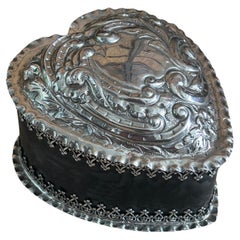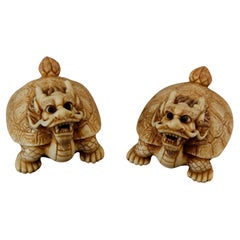Bone Decorative Boxes
Late 19th Century British Antique Bone Decorative Boxes
Metal, Silver
19th Century French Louis XIV Antique Bone Decorative Boxes
Brass
19th Century Japanese Antique Bone Decorative Boxes
Ivory, Paint
19th Century Japanese Antique Bone Decorative Boxes
Ivory, Paint
19th Century Japanese Antique Bone Decorative Boxes
Ivory, Paint
19th Century Japanese Antique Bone Decorative Boxes
Ivory, Paint
1820s Neoclassical Antique Bone Decorative Boxes
Other
19th Century Japanese Antique Bone Decorative Boxes
Ivory, Paint
19th Century Japanese Antique Bone Decorative Boxes
Ivory, Paint
19th Century Japanese Antique Bone Decorative Boxes
Ivory, Paint
1880s Japanese Antique Bone Decorative Boxes
Ivory, Paint
19th Century Japanese Antique Bone Decorative Boxes
Ivory, Paint
1880s Japanese Antique Bone Decorative Boxes
Ivory, Paint
1880s Japanese Antique Bone Decorative Boxes
Ivory, Paint
19th Century English Victorian Antique Bone Decorative Boxes
Ivory, Rosewood
1880s Chinese Other Antique Bone Decorative Boxes
Ivory
19th Century French Empire Antique Bone Decorative Boxes
Brass
Mid-19th Century Indian Anglo Raj Antique Bone Decorative Boxes
Bone, Antler, Wood
Mid-19th Century Indian Anglo Raj Antique Bone Decorative Boxes
Antler, Horn, Wood
Early 19th Century Chinese Chinoiserie Antique Bone Decorative Boxes
Bone, Wood, Lacquer
Mid-19th Century Indian Anglo Raj Antique Bone Decorative Boxes
Horn, Wood
Late 19th Century Sri Lankan Anglo Raj Antique Bone Decorative Boxes
Bone, Wood
19th Century Indian Anglo-Indian Antique Bone Decorative Boxes
Bone, Tortoise Shell
Late 19th Century British Antique Bone Decorative Boxes
Silver Plate
Mid-19th Century British Antique Bone Decorative Boxes
Gold Plate
1840s Swiss Early Victorian Antique Bone Decorative Boxes
Silver, Iron, Cut Steel, Steel, Bronze
Mid-19th Century British Antique Bone Decorative Boxes
Bone, Wood
1840s Swiss Early Victorian Antique Bone Decorative Boxes
Silver, Iron, Cut Steel, Steel, Bronze
1840s Swiss Early Victorian Antique Bone Decorative Boxes
Silver, Iron, Cut Steel, Steel, Bronze
1840s Swiss Early Victorian Antique Bone Decorative Boxes
Silver, Iron, Cut Steel, Steel, Bronze
1840s Swiss Early Victorian Antique Bone Decorative Boxes
Silver, Iron, Cut Steel, Steel, Bronze
1840s Swiss Early Victorian Antique Bone Decorative Boxes
Silver, Iron, Cut Steel, Steel, Bronze
Late 19th Century Indian Anglo Raj Antique Bone Decorative Boxes
Brass, Steel
Early 19th Century English Regency Antique Bone Decorative Boxes
Tortoise Shell, Mother-of-Pearl
19th Century Swiss Louis XV Antique Bone Decorative Boxes
Gold
Mid-19th Century Indian Anglo-Indian Antique Bone Decorative Boxes
Antler, Wood
Early 1800s English Georgian Antique Bone Decorative Boxes
Foil
19th Century Indian Anglo-Indian Antique Bone Decorative Boxes
Bone
1870s English Victorian Antique Bone Decorative Boxes
Bone, Wood, Ebony
Mid-19th Century Moroccan Anglo-Indian Antique Bone Decorative Boxes
Bone, Tortoise Shell
19th Century Antique Bone Decorative Boxes
Tortoise Shell
Early 1800s English Georgian Antique Bone Decorative Boxes
Foil
Late 19th Century Indian Anglo Raj Antique Bone Decorative Boxes
Bone, Precious Stone, Sandalwood
Late 19th Century Indian Anglo-Indian Antique Bone Decorative Boxes
Bone, Padouk, Sandalwood
19th Century Indian Anglo-Indian Antique Bone Decorative Boxes
Bone, Shell, Sandalwood
Late 19th Century Indian Anglo-Indian Antique Bone Decorative Boxes
Bone, Padouk, Sandalwood
Late 19th Century French Napoleon III Antique Bone Decorative Boxes
Brass
19th Century Indian Anglo-Indian Antique Bone Decorative Boxes
Bone, Padouk, Sandalwood
19th Century Antique Bone Decorative Boxes
Tortoise Shell
19th Century Antique Bone Decorative Boxes
Tortoise Shell
1820s English George IV Antique Bone Decorative Boxes
Crystal, Brass, Silver
Late 19th Century English Victorian Antique Bone Decorative Boxes
Metal
Mid-19th Century Afghan Chinoiserie Antique Bone Decorative Boxes
Bone, Wood, Lacquer, Paint
19th Century Indian Anglo-Indian Antique Bone Decorative Boxes
Silver
19th Century Swedish Antique Bone Decorative Boxes
Horn
Mid-19th Century Chinese Chinoiserie Antique Bone Decorative Boxes
Bone, Wood, Lacquer
1880s English Antique Bone Decorative Boxes
Sterling Silver
1880s French Antique Bone Decorative Boxes
Gold



